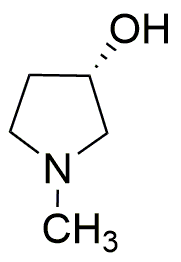(S)-(+)-1-Methyl-3-pyrrolidinol is widely utilized in research focused on
- Pharmaceutical Development: This compound serves as a key intermediate in the synthesis of various pharmaceuticals, particularly in the development of drugs targeting the central nervous system. Its unique structure allows for enhanced bioactivity compared to other similar compounds.
- Chiral Catalysis: It is used as a chiral catalyst in asymmetric synthesis, helping researchers create enantiomerically pure compounds. This is crucial in the production of many drugs where the specific orientation of molecules can significantly impact efficacy.
- Flavor and Fragrance Industry: The compound is also applied in the formulation of flavors and fragrances, providing a distinctive scent profile that enhances consumer products such as perfumes and food additives.
- Material Science: In polymer chemistry, it is utilized as a building block for creating specialty polymers with unique properties, which can be tailored for specific applications in coatings and adhesives.
- Research in Neuroscience: Its role in neuroscience research is significant, as it is studied for its potential effects on neurotransmitter systems, offering insights into the development of treatments for neurological disorders.
General Information
Properties
Safety and Regulations
Applications
(S)-(+)-1-Methyl-3-pyrrolidinol is widely utilized in research focused on
- Pharmaceutical Development: This compound serves as a key intermediate in the synthesis of various pharmaceuticals, particularly in the development of drugs targeting the central nervous system. Its unique structure allows for enhanced bioactivity compared to other similar compounds.
- Chiral Catalysis: It is used as a chiral catalyst in asymmetric synthesis, helping researchers create enantiomerically pure compounds. This is crucial in the production of many drugs where the specific orientation of molecules can significantly impact efficacy.
- Flavor and Fragrance Industry: The compound is also applied in the formulation of flavors and fragrances, providing a distinctive scent profile that enhances consumer products such as perfumes and food additives.
- Material Science: In polymer chemistry, it is utilized as a building block for creating specialty polymers with unique properties, which can be tailored for specific applications in coatings and adhesives.
- Research in Neuroscience: Its role in neuroscience research is significant, as it is studied for its potential effects on neurotransmitter systems, offering insights into the development of treatments for neurological disorders.
Documents
Safety Data Sheets (SDS)
The SDS provides comprehensive safety information on handling, storage, and disposal of the product.
Product Specification (PS)
The PS provides a comprehensive breakdown of the product’s properties, including chemical composition, physical state, purity, and storage requirements. It also details acceptable quality ranges and the product's intended applications.
Certificates of Analysis (COA)
Search for Certificates of Analysis (COA) by entering the products Lot Number. Lot and Batch Numbers can be found on a product’s label following the words ‘Lot’ or ‘Batch’.
*Catalog Number
*Lot Number
Certificates Of Origin (COO)
This COO confirms the country where the product was manufactured, and also details the materials and components used in it and whether it is derived from natural, synthetic, or other specific sources. This certificate may be required for customs, trade, and regulatory compliance.
*Catalog Number
*Lot Number
Safety Data Sheets (SDS)
The SDS provides comprehensive safety information on handling, storage, and disposal of the product.
DownloadProduct Specification (PS)
The PS provides a comprehensive breakdown of the product’s properties, including chemical composition, physical state, purity, and storage requirements. It also details acceptable quality ranges and the product's intended applications.
DownloadCertificates of Analysis (COA)
Search for Certificates of Analysis (COA) by entering the products Lot Number. Lot and Batch Numbers can be found on a product’s label following the words ‘Lot’ or ‘Batch’.
*Catalog Number
*Lot Number
Certificates Of Origin (COO)
This COO confirms the country where the product was manufactured, and also details the materials and components used in it and whether it is derived from natural, synthetic, or other specific sources. This certificate may be required for customs, trade, and regulatory compliance.


